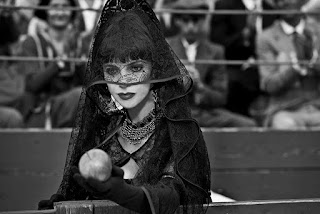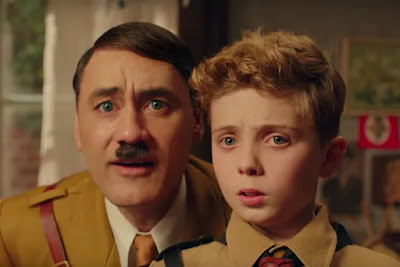Some Thoughts:
'Nother decade, huh? I'll have to confess that the last one changed without my really noticing. I was reminded earlier this year that I'd started the film night that created this blog ten years ago. As 2009 ended I'd spent the best part of a year programming screening sequences by the half season, writing up the selections and even editing trailers for them. I'd turn up every Friday evening, shamble up Smith St and into Milos' place, checking the projector and av receiver, run a little of the feature and support and then wait with a coffee and noodle at the piano until people turned up, if they did. Things were different then but they were already changing.
The arthouses, whose demise had happened in the mid-00s, had not come back and there were only a few of us trying to address the gap in the inner city. We didn't yet have streaming video and the few US cable shows that were easily available on free to air tv were being shunted to difficult timeslots that meant we saw them as recordings rather than at the same time. Blu-ray was available but wasn't going to take DVD over as it meant getting a new machine and possibly replacing a whole collection. I was still sourcing the selections through a lot of international online retailers and even other means.
Few remain now and all power to them but cinema ain't what it used to be as far as how you get in front of it goes. Plenty of style changes, too, but that distribution disruption has done the most, and it's not all damage. Social media expanded with the continued monetisation of arenas like YouTube. Wince all we like, it has meant more content available of new voices with instant access and the resurfacing of obscurities worth our attention. This is almost the same as the local introduction of video on demand streaming which has brought the same kind of thing as YouTube but at a guaranteed audiovisual quality and often surprising creative tone. The adoption of it by rising names in cinema as well as old stagers like Scorsese will keep this going.
That has meant, though, that free to air tv which long abandoned movie marathons and strong new programming is all but unwatchable and on the death spiral. We're still waiting for Shudder (and Ozflix only works with Chromecast) but Disney, Amazon Prime and other interests have either moved in or are soon to. Too much choice? Probably, considering that none of these is free outside of the tv channels demand viewing resources and oddities like TubiTV.
Arthouse cinemas starved to death in the 2000s and much of their content went into streaming but this still means that there is a potential ocean of it that is even harder to discover without going off the map, now. Parasite has proved a stayer at Melbourne cinema Nova and maybe, just maybe, something like a swell of interest in filmmakers like Takeshi Miike or Hong Sang-Soo could be organised. Then again, Hoyts in Melbourne at least is screening good presentations of Chinese and Indian films in response to the local market so who knows?
And there are new names to watch. Ari Aster for his own brand of strong psycho drama that can spin off into outright horror or remain within the realm of fable while still appearing to be naturalistic (after a fashion). Jordan Peele brings his comedy scholarship to social commentary in movies that inform but forget not to entertain. Justin Benson and Aaron Morehead are building a kind of shadow Lovecraftian universe quietly in Mumblecore Corner and it's taking. Jennifer Kent stunned us with The Babadook and proved there was more in there with The Nightingale.
An unannounced wave of magical realism from south of the US border began making itself felt in the festival circuit with titles like the extraordinary and devastating Tigers are Not Afraid. A wave of meanspirited horror remakes dragged the genre down to the gutter, missing the point of the originals and going for big reveals. The Conjurverse gave us the jumpscare fests and bled into nearby galaxies to create likeminded rubbish like Sinister or the 2012 version of The Woman in Black. I hated every one of these violations but had to admit that their success led to funding for more genre output. I had no interest in the Marvel Comic Universe but also had to admit its clout and shook my head when Scorsese and Coppola both declared the films uncinematic. Of those old masters I had to admit I preferred the Scorsese exhibition to any of his output in the decade, being unable to muster interest in seeing a story about Christian missionaries in medieval Japan.
I enjoyed the transition of found footage as an aesthetic to a broader lo-fi field with some intriguing results like Yellow Brick Road, Banshee Chapter, the Creep movies, Unfriended, until productions like the surprisingly sombre and effective Satanic managed to make a fair tilt at mainstream clean light with some genuine original horror. The unsung hero of low-means film production was the drone, allowing for aerial shots on a budget. Elsewhere, the creation of online folkore through Reddits and video platforms bore intriguing fruit with creepypastas and the like which had a shivery homemade authenticity. On the outer verges, yes, but this, too, is cinema at least by intention.
Strangely, we also saw the revival of stable film production like Val Lewton in the '40s or Roger Corman in the '60s. A24 gave us a number of intriguing pieces that used genre as a tone or colour but provided solid social commentary like MidSommar, It Comes at Night or A Quiet Place. This gave rise for the silly description of elevated horror but that didn't harm the films themselves. Blumhouse seemed to take a throw it out there and see if it works approach resulting in a mixed bag that was interesting rather than tiresome.
Before my final ten, here's a grab bag of wondermints from the era just going:
Satanic, Sorry to Bother You, Tigers Are Not Afraid, Evolution, The Artist, Tabu, Climax, anything by Hong Sang Soo, The Invitation, The Reef, Banshee Chapter, Beasts of the Southern Wild, End of Animal, Spring Breakers, Why Don't You Play in Hell, The Sound of My Voice, Planet of Snail, Blue is the Warmest Colour, Snowtown, Amy, Son of Saul, Fear Itself, Kedi, Hereditary, The Nightingale, What We Do in the Shadows, Wounds, Unfriended, Under the Skin, Snowpiercer, Blue Valentine, In Fabric, A quiet Place, The Shape of Water, Thoroughbreds, Tragedy Girls, Tully, Lucky, Excision, The Hole in the Ground, Borderlands, A Gentle Creature, Mother!, A Ghost Story, Hard to be a God, Moonlight, Raw, Ingrid Goes West, It Comes at Night, Ich Sehe Ich Sehe, The Unknown Girl, I, Daniel Blake, The Forbidden Room, Birdman, Ex Machina, The Lobster, Wadjda, Predestination, Nightcrawler, The Bling Ring, Rhino Season, Martha Macy May Marlene, Chronicle, The Master, Uncle Boonmee who Can Remember His Past Lives, The Woman, Killing Ground.
And all this is still just surface scratching. I probably went to the cinema more regularly in the last ten years than any other decade and that was supplemented by streaming services. We're doing ok. I declare the 2010's to be a great decade of cinema.
The following, one from each year, are not necessarily what I might consider the best but all of them have stayed with me. I won't include lowlights except to say that Noah Baumbach, Wes Anderson and James Wan and cronies should stop making films.
2010
Black Swan - Darren Aranofsky makes a muscular paranoia fantasy out of ballet. Can't want more than that. Natalie Portman and Mila Kunis? Ok, maybe that much more.
2011
The Turin Horse - Bela Tarr bows out of cinema with an apocalyptic piece so patient and intense it's difficult to return to but so impressive that it never leaves your mind anyway.
2012
Berberian Sound Studio - The first Peter Strickland film I saw and it made me what I believe will be a lifelong fan. Start in an imagined genre world and then mix it up with razors on your fingers. Beautiful. Powerful.
2013
Blancanieves - Who says silent cinema can't engage? This extraordinary late entry doesn't just engage, it enchants.
2014
The Babadook - A marvellous if brutal exploration of grief, exhaustion and guilt and the monsters they create.
2015
It Follows - Not as claimed at the time a regression to the teenage sex=death equation, this retro-toned horror brought us a far scarier protean threat borne of responsibility.
2016
Under the Shadow - A kind of porting of Dark Water to an even more oppressive cultural situation as a mother and daughter struggle in the theocratic dictatorship of the Ayatolla's Iran. Inside is danger but outside is hatred.
2017

Get Out - social satire woven deep into science-horror from the mind that successfully rebooted the Twilight Zone. He did it again this year with US. He will do it again. I will be in the queue.
2018
The Favourite - From Greek Weirdcore to the edge of the mainstream, Yorgos Lanthimos has beat a steady path. With this tale of ambition and shifting empathy he shows us why all that struggle was worth it.
2019

Portrait of a Lady on Fire - Sublime, deep and heavily affecting, this tale of love on a clock and the importance of moments could not be a better means to round off ten years of great cinematic change.
That's it. Time for a nap. See youse next decade,
PJ
















































